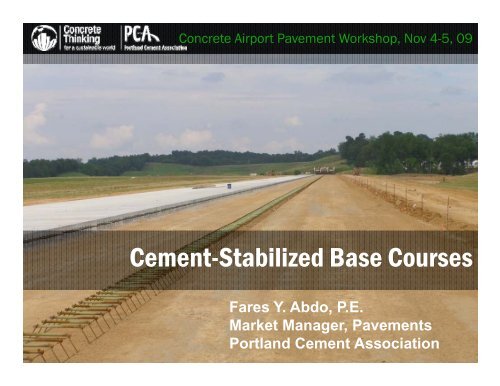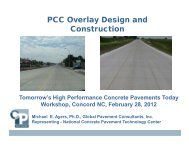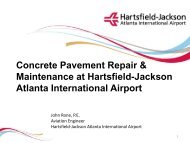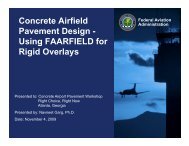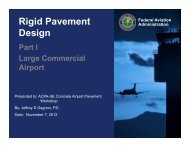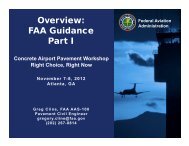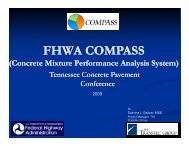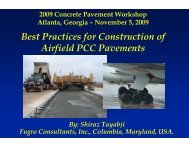Cement-Stabilized Base Courses Cement Stabilized Base Courses
Cement-Stabilized Base Courses Cement Stabilized Base Courses
Cement-Stabilized Base Courses Cement Stabilized Base Courses
Create successful ePaper yourself
Turn your PDF publications into a flip-book with our unique Google optimized e-Paper software.
Concrete Airport Pavement Workshop, Nov 4-5, 09<br />
<strong>Cement</strong>-<strong>Stabilized</strong> <strong>Cement</strong> <strong>Stabilized</strong> <strong>Base</strong> <strong>Courses</strong><br />
Fares Y. Abdo, P.E.<br />
,<br />
Market Manager, Pavements<br />
Portland <strong>Cement</strong> Association
<strong>Cement</strong>-Treated <strong>Base</strong> <strong>Courses</strong><br />
Fundamentals<br />
Materials<br />
Mix Design<br />
Thickness Design g<br />
Construction<br />
Case Studies
<strong>Cement</strong>-<strong>Base</strong>d Pavement Materials<br />
Roller Roller-Compacted<br />
Compacted<br />
Pervious<br />
Conventional<br />
Concrete<br />
Concrete<br />
Concrete<br />
FAA<br />
Econocrete<br />
P-306<br />
FAA<br />
C<strong>Cement</strong>-Treated t T t d<br />
<strong>Base</strong>/Subbase<br />
P-301 &<br />
Soil-<strong>Cement</strong><br />
<strong>Cement</strong>-<br />
Treated<br />
<strong>Base</strong><br />
P-304 Flowable Fill<br />
<strong>Cement</strong><br />
Conteent<br />
Full-Depth<br />
Reclamation<br />
<strong>Cement</strong>-Modified<br />
Soil<br />
Water Content
Definition<br />
<strong>Cement</strong>-Treated <strong>Base</strong> – a intimate mixture of<br />
native and/or manufactured aggregates with<br />
measured amounts of portland cement (and<br />
possibly other cementitious materials) and<br />
water that hardens after compaction and curing<br />
to form a strong durable paving material
What materials can be treated with cement?<br />
Soils (sand, silt, clay)<br />
Gravel<br />
Shale<br />
CCrushed h d stone t<br />
Slag<br />
Recycled HMA<br />
Recycled concrete
Are all materials suitable for CTB?<br />
Problem Soils<br />
Organic soils<br />
Acid soils<br />
Sulfate Sulfate soils<br />
Uniform sands
Why Use CTB?<br />
Economical pavement base<br />
Decreased base thickness compared to<br />
unbound aggregate base<br />
Structural properties maintained under varying<br />
moisture conditions<br />
High stiffness inhibits fatigue cracking and<br />
rutting of asphalt surface<br />
Sustainable paving option
FAA <strong>Base</strong>/Subbase Approved<br />
FAA <strong>Base</strong>/Subbase Approved<br />
Materials
P Purpose of f <strong>Base</strong>/Subbase B /S bb <strong>Courses</strong> C<br />
Flexible pavements<br />
(FAA AC 150/5320-6E)<br />
Asphalt<br />
Principal structural components <strong>Base</strong><br />
Principal structural components<br />
Distribute the loads to the<br />
f d ti<br />
Subbase<br />
(Req. if CBR
Improved Performance in Rutting and Fatigue Cracking<br />
P P<br />
Unstabilized Granular <strong>Base</strong><br />
<strong>Cement</strong>-Treated <strong>Base</strong>
P Purpose of f <strong>Base</strong>/Subbase B /S bb <strong>Courses</strong> C<br />
Flexible pavements<br />
(FAA AC 150/5320-6E)<br />
Asphalt<br />
Principal structural component <strong>Base</strong><br />
Principal structural component<br />
Distribute the loads to the<br />
ffoundation d ti<br />
Rigid pavements<br />
Provide uniform stable support<br />
Subbase<br />
(Req. if CBR
Materials for <strong>Base</strong> Course<br />
FAA AC 150/5320-6E Flexible Pavement Design<br />
IItem B <strong>Base</strong> CCourse M Max. G Gross LLoad, d<br />
lbs.<br />
P-208 P 208 Aggregate <strong>Base</strong> 60 60,000 000<br />
P-209 Crushed Aggregate <strong>Base</strong> 100,000<br />
P-211 Lime Rock <strong>Base</strong> N/A /<br />
P-219 Recycled Concrete Aggregate <strong>Base</strong> 100,000<br />
P-304 <strong>Cement</strong> Treated <strong>Base</strong> N/A /<br />
P-306 Econocrete Subbase N/A<br />
P-401 Plant Mix Bituminous Pavements N/A<br />
P-403 HMA <strong>Base</strong> N/A
Materials for Subbase Course<br />
FAA AC 150/5320-6E Flexible Pavement Design<br />
IItem SSubbase bb CCourse1 F P i<br />
1 Frost Penetrating<br />
Subbase<br />
P-154 P 154 Subbase Course<br />
<br />
P-210 Caliche <strong>Base</strong> Course <br />
P-212 Shell <strong>Base</strong> Course <br />
P-213 Sand Clay <strong>Base</strong> Course X<br />
P-301 Soil <strong>Cement</strong> <strong>Base</strong> Course X<br />
1. Materials acceptable for base course can also be used for subbase course
Materials for Sbbase Course<br />
FAA AC 150/5320-6E Rigid Pavement Design<br />
IItem SSubbase bb CCourse M Max. G Gross LLoad, d<br />
lbs.<br />
P-154 Subbase Course 100,000 ,<br />
P-208 Aggregate <strong>Base</strong> Course 100,000<br />
P-209 Crushed Aggregate <strong>Base</strong> Course 100,000<br />
P-211 Lime Rock <strong>Base</strong> Course 100,000<br />
P-301 Soil <strong>Cement</strong> <strong>Base</strong> Course 100,000<br />
PP-304 304 <strong>Cement</strong> Treated <strong>Base</strong> Course N/A<br />
P-306 Econocrete Subbase Course N/A<br />
P-401 Plant Mix Bituminous Pavements N/A<br />
P-403 HMA <strong>Base</strong> Course N/A
Engineering Properties of CTB<br />
PProperty1 FAA P 301 FAA P 304 PCA CTB<br />
1 FAA P-301 FAA P-304 PCA CTB<br />
(Soil <strong>Cement</strong>)<br />
(CTB)<br />
7-Day Compressive N/A2 Under PCC: 300 min.;<br />
Strength, psi 500 min.; 1000 max.<br />
Under HMA:<br />
750 min.; 1000 max.<br />
800 max.<br />
Elastic Modulus, ksi 250 500 600-1000<br />
Poisson’s Ratio 0.20 0.20 0.15<br />
1. Refer to FAA AC 150/5320-6E for durability requirements<br />
2. FAA recommendations for P-301 are based on wet-dry and freeze-thaw tests<br />
and strength should increase with age
CTB Mix Design
St Strive i for f a Balance B l Between B t<br />
Strength g<br />
and Performance
Mixture Design-Step 1<br />
Determine moisture-density relationship<br />
Select expected median cement content<br />
(e.g. 6% by estimated dry weight)<br />
Perform standard or modified Proctor test<br />
(ASTM D558 or ASTM D1557)<br />
Construct moisture-density curve<br />
Determine optimum moisture content and<br />
maximum dry density
Moisture-Density Relationship
Mix Design-Step 2<br />
Mold specimens for compressive strength testing<br />
Select range of cement contents<br />
( (e.g. 4% 4%, 6% and d 8% b by d dry weight i ht of f material) t i l)<br />
Use percent OMC from Step 1 and Mold two<br />
specimens per cement content (ASTM<br />
D559/560 or ASTM D1632)<br />
Perform compressive strength testing<br />
(ASTM D1633)<br />
Plot cement content versus compressive<br />
Plot cement content versus compressive<br />
strength
Strength Testing
7-dayy<br />
Compresssive<br />
Strenngth,<br />
psi<br />
Strength vs. <strong>Cement</strong> Content<br />
1000<br />
900<br />
800<br />
700<br />
600<br />
500<br />
400<br />
300<br />
200<br />
3 4 5 6 7 8 9<br />
<strong>Cement</strong> Content, %
Mix Design-Step 3<br />
Determine moisture-density relationship of target<br />
cement content<br />
Perform standard or modified Proctor test<br />
(ASTM D558 or ASTM D1557)<br />
Construct moisture-density curve<br />
Determine optimum moisture content and<br />
Determine optimum moisture content and<br />
maximum dry density
Durability Testing<br />
Specimens containing various cementitious<br />
contents molded per ASTM D558 and tested per:<br />
ASTM D559; wet-dry cycles<br />
ASTM D560; freeze-thaw freeze thaw cycles<br />
Select min. cement content that meets weight<br />
loss limits set by agency having jurisdiction
Thickness Design
Thickness Design<br />
■ FAA: FAARFIELD Computer Program<br />
■ PCA Methods of Thickness Design<br />
■ Experience<br />
■ MMechanistic-Empirical h i ti E i i l MMethods th d<br />
■ AASHTO MEPDG (guide accepted)<br />
■ PCA-Pave (near completion)
Thickness Design<br />
■ Factors<br />
■ Subgrade Strength<br />
■ Pavement Design Period<br />
■ TTraffic ffi<br />
■ Typical Thickness<br />
■ Heavy traffic: 6 to 9 inches<br />
■ Highways and airport runways and<br />
g y p y<br />
taxiways: 6 to 12 inches
Construction
Construction<br />
■ Two methods<br />
■ Plant Mix<br />
■ Road Mix (in (in-place)<br />
place)
Plant Mix: Puggmill<br />
High production<br />
Usually close or on-site<br />
Mob/demob cost
Continuous Pugmill Mixing Chamber
Plant Mix: Central Concrete Batch Plant<br />
■ Highly accurate<br />
proportioning<br />
■ Local availability<br />
■ Smaller output<br />
capacity<br />
■ Longer mix times than<br />
conventional concrete<br />
■ Frequent cleaning<br />
■ Dedicated production
Plant Mix: Dry Concrete Batch Plant<br />
■ Highest local availability<br />
■ Desirable method for the<br />
smaller-sized jobs<br />
■ 2-step process<br />
■ Feed into transit mixers<br />
■ Discharge into dumps<br />
■ Low production<br />
■ Frequent cleaning<br />
■ SSegregation i
Construction - Road Mix<br />
■ In-situ or mixed in place materials<br />
■ Wider variety of materials<br />
■ Dry yo or slurry su yce cement e tapp application cato method et od
Road Mix Method<br />
1. Spread cement<br />
2. Add water if necessary and mix<br />
3. Compact p<br />
4. Grade<br />
55. Cure
Portland <strong>Cement</strong> Addition<br />
Slurry spread<br />
Dry spread
Addition of Water<br />
Via drum of mixer<br />
Gravity dump and mix
Road Mixing<br />
Without water<br />
With water
Plant vs. Road Mix Considerations<br />
Traffic loading/agency requirements<br />
FAA P-304 spec includes plant mix only<br />
Quality Q yof<br />
in-situ materials<br />
Cost<br />
Haul distances: material sources, plant, p jjobsite<br />
Design thickness (one or multiple lifts)<br />
Sustainable considerations (Reduce, Reuse and Recycling)
Plant vs. Road Mix Considerations<br />
Dust controls/location of project<br />
Tuscaloosa, AL Palo Verde, AZ
Spreading/Placing
Grading/Compaction
Compaction<br />
■ High density is critical<br />
for strength and<br />
durability<br />
■ Steel-drum<br />
■ Rubber-tire roller<br />
■ Sheepsfoot roller
Curing<br />
■ Required for surface durability and normal strength<br />
gain g<br />
■ Needed to retain moisture<br />
■ Three methods:<br />
▪ Moist Cure<br />
▪ Concrete Curing Compound<br />
▪ Asphalt Emulsion
Moist Cure<br />
■ Continuous<br />
operation<br />
P t i<br />
■ Prevent excessive<br />
drying
Concrete Curing Compound<br />
■ White-pigmented<br />
concrete curing<br />
compounds<br />
■ Provide adequate<br />
coverage<br />
■ May form a bond<br />
breaker
Bituminous Curing Compound<br />
■ EExcellent ll t<br />
moisture barrier<br />
G d f h lt<br />
■ Good for asphalt<br />
cap
Applications
Where are stabilized materials used?<br />
L Low volume l roadways r d<br />
Residential streets<br />
State routes<br />
Interstate highways<br />
Airport runways and taxiways<br />
Parking lots<br />
Industrial storage facilities<br />
Port facilities<br />
Truck terminals<br />
Commercial sites<br />
In other words…<br />
any pavement structure!
Residential Streets<br />
Bells Crossing, Mooresville, NC, 2008
Example: County Road Original<br />
■ Upgrade 2-lane to 4-lane route<br />
■ Value Value-Engineered Engineered Option<br />
■ $900,000 savings on<br />
238,000 SY ($3.78/SY)<br />
Design<br />
Asphalt Int. &<br />
Surface<br />
■ Faster construction (5 ( months<br />
savings)<br />
3.5” Asphalt <strong>Base</strong><br />
■ Less mined and processed<br />
materials<br />
8” 8<br />
Crushed<br />
Stone <strong>Base</strong><br />
Subgrade<br />
8”<br />
VValue- l<br />
Engineered<br />
Option<br />
Asphalt Int. &<br />
Surface<br />
Crushed C<strong>Cement</strong>- t<br />
Treated Stone <strong>Base</strong> <strong>Base</strong><br />
Subgrade<br />
SC County Road 5
4” 4<br />
Parking Areas<br />
Design/Bid As<br />
Section Constructed<br />
Asphalt<br />
12” Crushed<br />
12” Crushed<br />
12” Stone<br />
<strong>Base</strong><br />
Subgrade<br />
6” 6”-8” 8”<br />
6” 6<br />
RCC<br />
Soil-<strong>Cement</strong><br />
<strong>Base</strong><br />
Subgrade<br />
BMW, SC, 2009<br />
Sustainable Contributions<br />
■ Reduced<br />
export/import/fuel use<br />
■ Less mined and<br />
processed materials<br />
■ Reduced excavation<br />
■ Faster construction<br />
■ Cooler pavement<br />
■ Used in in-situ situ materials<br />
■ Less damage to area<br />
roads
Washington Dulles<br />
Airport p Runway y 4, , 2008<br />
18” PCC w/<br />
dowelled transverse<br />
jjoints i t at t 20 ft<br />
6” CTB, 6% cement<br />
12” <strong>Cement</strong>-<br />
<strong>Stabilized</strong> Subgrade,<br />
5% cement
Washington Dulles<br />
Airport p Runway y 4<br />
■ Runway 4 completed in 2008<br />
■ Runway 12 was completed in<br />
2004
FedEx Hub at Alliance<br />
Airport Fort Worth, TX,<br />
1997<br />
Taxiway & Ramp<br />
Truck Terminal &<br />
14” PCC CContainer t i St Storage g<br />
9” CTB<br />
9” <strong>Cement</strong>-Treated<br />
Subgrade<br />
10” JRCP<br />
6” <strong>Cement</strong>-Treated<br />
Subgrade
FedEx Hub at Alliance Airport Fort Worth, TX<br />
■ 50-yr design life<br />
■ CCompleted l t d in i 1997<br />
■ 330,000 yd 2<br />
■ <strong>Cement</strong>-treated subgrade<br />
■ 7 % cement, 250 psi,<br />
reduced PI from 38 to less<br />
than 12<br />
■ <strong>Cement</strong> –treated treated base<br />
■ 750 psi at 28 days
DFW SE Perimeter<br />
Taxiway, y, 2008<br />
■ First perimeter taxiway in U.S.<br />
■ Built for safety and reduce<br />
congestion delays<br />
18” 18 CRCP<br />
12” CTB<br />
12” Lime-Treated<br />
Subgrade
DFW SE Perimeter<br />
Taxiway<br />
■ Completed in 2008<br />
■ 225,000 yd 2<br />
■ Data will be analyzed before<br />
building the remaining 3 loops
McGhee Tyson Airport<br />
Knoxville, TN, 2008<br />
■ Completed in 2008<br />
■ 9,000 yd2 ■ CTB per FAA PP-304 304<br />
16” PCC<br />
6” CTB, 5% (C+FA)<br />
8” Lime-Treated<br />
Subgrade
Charlotte-Douglas<br />
Airport, 2008<br />
■ Completed in 2008<br />
■ 256,000 yd2 ■ CTB per FAA PP-304 304
Dover AFB, Delaware,<br />
2008<br />
■ Old concrete and asphalt<br />
crushed and recycled<br />
■ 50% recycled l d and d 50% iin-situ i<br />
soil; sandy clays and clear<br />
sand<br />
■ CTB 12 12” thick<br />
■ 42 to 80 lb/SY depending on<br />
the in-situ and recycled<br />
materials<br />
■ 300,000 SY<br />
■ 58 days
M More Information<br />
I f ti<br />
www.cement.org/pavements<br />
fabdo@cement.org


